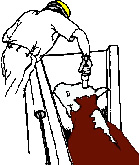
| Animals | Number Killed |
|---|---|
| Chickens | |
| Ducks | |
| Pigs | |
| Rabbits (2024) [2] | |
| Sheep | |
| Turkeys | |
| Goats | |
| Cattle | |
| Rodents | |
| Pigeons and other birds | |
| Water buffalo | |
| Dogs (low-end estimate 2016) [3] | |
| Horses | |
| Camels | |
| Deer (in tonnes of meat) | |
| Donkeys | |
| Other camelids | |
| Mules |
Animal slaughter is the killing of animals, usually referring to killing domestic livestock. It is estimated that each year, 80 billion land animals are slaughtered for food. [4] Most animals are slaughtered for food; however, they may also be slaughtered for other reasons such as for harvesting of pelts, being diseased and unsuitable for consumption, or being surplus for maintaining a breeding stock. Slaughter typically involves some initial cutting, opening the major body cavities to remove the entrails and offal but usually leaving the carcass in one piece. Such dressing can be done by hunters in the field (field dressing of game) or in a slaughterhouse. Later, the carcass is usually butchered into smaller cuts.
Contents
- Modern history
- Methods
- Stunning
- Killing
- Preslaughter handling
- National laws
- Europe
- Canada
- United Kingdom
- United States
- Religious laws
- Jewish law (Shechita)
- Islamic law (Dhabihah)
- Sikh customs (Jhatka)
- Effects on livestock workers
- Public attitudes
- Animal welfare
- See also
- References
- External links
The animals most commonly slaughtered for food are cattle and water buffalo, sheep, goats, pigs, deer, horses, rabbits, poultry (mainly chickens, turkeys, ducks and geese), insects (a commercial species is the house cricket), and increasingly, fish in the aquaculture industry (fish farming). In 2020, Faunalytics reported that the countries with the largest number of slaughtered cows and chickens are China, the United States, and Brazil. Concerning pigs, they are slaughtered by far the most in China, followed by the United States, Germany, Spain, Vietnam, and Brazil. For sheep, again China slaughtered the most, this time followed by Australia and New Zealand. Similarly, the amount (in tonnes) of fish used for production is highest in China, Indonesia, Peru, India, Russia, and the United States (in that order). [5]








